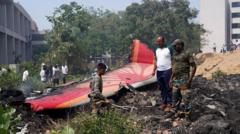Air India has confirmed the retrieval of vital data from the flight recorders of its Boeing 787-8 Dreamliner, which tragically crashed shortly after takeoff near Ahmedabad airport on June 12. This marks a significant advancement in the ongoing investigation into the disaster, which resulted in the loss of at least 270 lives.
Following the crash, the Enhanced Airborne Flight Recorders (EAFRs), commonly referred to as "black boxes," were recovered by investigators from the crash site. The initial recoveries took place over two days—on June 13 and June 16—one found on a rooftop and the other within the wreckage. With both pieces of equipment now in hand, the investigation team, led by India's Aircraft Accident Investigation Bureau (AAIB), alongside the US National Transportation Safety Board (NTSB), has begun its preliminary analysis of the data recorded.
The EAFRs equipped in this specific aircraft model are instrumental, capturing comprehensive flight data and cockpit audio. The detailed records include critical information related to gear and flap positions, engine performance, fuel flow, and cockpit communications, all of which are essential for reconstructing the flight's final moments and understanding the circumstances surrounding the accident.
The Indian civil aviation ministry indicated that the analysis is already under progress, with a focus on piecing together the events leading to this tragic incident to discover any contributing elements and avoid future accidents. NTSB chair Jennifer Homendy also emphasized the importance of sharing findings in a timely manner for public safety and awareness.
However, some experts have raised concerns regarding the time it took to download the data from the recorders, labeling the delay as unusual for such investigations. Air India Flight 171 had been airborne for under 40 seconds before its catastrophic descent, resulting in the death of 241 out of the 242 passengers onboard, marking it as one of India's most perplexing air disasters in recent history. The tragedy occurred shortly after the aircraft took off at 13:39 local time, followed by a mayday call just moments later, which remains the flight's final communication.
Following the crash, the Enhanced Airborne Flight Recorders (EAFRs), commonly referred to as "black boxes," were recovered by investigators from the crash site. The initial recoveries took place over two days—on June 13 and June 16—one found on a rooftop and the other within the wreckage. With both pieces of equipment now in hand, the investigation team, led by India's Aircraft Accident Investigation Bureau (AAIB), alongside the US National Transportation Safety Board (NTSB), has begun its preliminary analysis of the data recorded.
The EAFRs equipped in this specific aircraft model are instrumental, capturing comprehensive flight data and cockpit audio. The detailed records include critical information related to gear and flap positions, engine performance, fuel flow, and cockpit communications, all of which are essential for reconstructing the flight's final moments and understanding the circumstances surrounding the accident.
The Indian civil aviation ministry indicated that the analysis is already under progress, with a focus on piecing together the events leading to this tragic incident to discover any contributing elements and avoid future accidents. NTSB chair Jennifer Homendy also emphasized the importance of sharing findings in a timely manner for public safety and awareness.
However, some experts have raised concerns regarding the time it took to download the data from the recorders, labeling the delay as unusual for such investigations. Air India Flight 171 had been airborne for under 40 seconds before its catastrophic descent, resulting in the death of 241 out of the 242 passengers onboard, marking it as one of India's most perplexing air disasters in recent history. The tragedy occurred shortly after the aircraft took off at 13:39 local time, followed by a mayday call just moments later, which remains the flight's final communication.





















